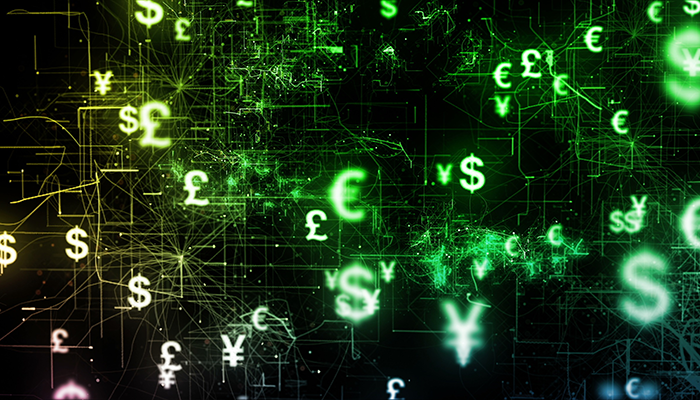“Money itself is changing,” IMF chief Christine Lagarde said in a speech in November last year. Addresing the Singapore Fintech Festival, she asked: “In ten, twenty, thirty years, who will still be exchanging pieces of paper?”
Electronic payments are becoming the norm. Signs now say ‘card only’ in many shop windows and we can pay for low-value goods with a simple tap of our card or even our phones thanks to a range of mobile apps.
In the UK, cash still accounts for just over a third of all payments. But this is predicted to fall to just 16% by 2027 according to UK Finance, the trade association for the banking and finance sector. In Sweden, cash has been virtually eliminated. Only 2% of transactions made in economy are now in cash, according to the Swedish central bank Riksbank.
IMF research, which explored the idea of digitalised money, has also suggested the demand for cash is decreasing while awareness is growing of virtual currencies, such as Bitcoin. Its report, Casting Light on Central Bank Digital Currency, says: “Digitalisation is reshaping economic activity, shrinking the role of cash, and spurring new digital forms of money. Central banks have been pondering whether and how to adapt.”
Although electronic payments are on the rise, the financial system is still based on physical money, printed by central banks. Commercial banks and private payment systems like Visa and Mastercard enable us to make electronic payments.
Cryptocurrencies grew in popularity after the 2008 financial crash as the public lost trust in the banking system, says Mike Seiferling, director of research on cryptocurrency and government at IE Business School in Madrid and public finance lecturer at UCL. However, cryptocurrencies work more like an asset (see box below) and cannot be used to purchase goods and the lack of regulation has proved a concern.
While governments try to figure out how to regulate virtual coins, central banks are looking into whether they should launch their own digital currencies. 
Unlike cryptocurrences, digital currencies issued by a central bank would have the same value as a cash currency – and could be spent on goods and services. Both would likely use some sort of digital ledger technology, such as blockchain.
Digital currency might soon become a reality. Lagarde, in Singapore, said that “we should consider the possibility” of central banks issuing digital currencies and supplying money to the digital economy.
Such digital currency issued by a central bank would be a liability of the state – as cash is – rather than commercial banks or private payment providers. She added that a state-controlled digital currency would have “clear advantages” and could fix the financial system in ways the private sector can’t.
“Central banks would retain a sure footing in payments,” she highlighted.
“Central banks would retain a sure footing in payments,” Christine Lagarde, IMF managing director
Although financial institutions would still play a role, she suggested that by introducing a digital currency managed by central banks, “your payment would be immediate, safe, cheap and potentially semi-anonymous”.
Claire Ingram Bogusz, a post-doctoral researcher at the Stockholm School of Economics, tells PF International that a digital currency could “cut out the middle man” – commercial banks – for citizens, making transactions faster and cheaper.
She adds that down the line, it could even be possible for people to hold bank accounts with the central bank or get their mortgage from the state.
Seiferling agrees: “There are a lot of unnecessary middle men in the current system. A digital currency could potentially cut the costs of this aspect of the system.”
As most digital currency transactions would be recorded on a single centralised ledger, the central bank or government would be able to see where money is flowing to, which could help tackle corruption, Gary Nuttall, a blockchain consultant, tells PF International. A digital ledger, where you can see money flows in real time, would be “a very fascinating thing for a government” because they could spot illegal transactions and financial activity, he says.
A digital ledger, where you can see money flows in real time, would be “a very fascinating thing for a government”, Gary Nuttall, blockchain consultant
Sweden is one country that has been exploring the possibility of launching its own digital currency. The mooted e-krona would be a purely electronic version of the Scandinavian country’s currency, the Swedish Krona and issued by its central bank, the Riksbank.
Ingram Bogusz notes that Sweden is already “more or less cashless” and in many ways relies heavily on credit card transactions – and private providers such as Visa and MasterCard. Swish, a mobile payment system launched by six Swedish banks in cooperation with the central bank, is currently a popular digital payment system used in Sweden.
A digital currency would remove this dependency on the private sector and allow for something cheaper, “homegrown” and state-controlled, she says.
There are, however, questions about the technology required to support a digital currency.
A Riksbank spokesperson told PF International that “blockchain technology or some other form of ‘distributed ledger technology’ was considered immature in the current situation” to use for the e-krona.
A Riksbank [see right] report concluded that current distributed ledger technology was inefficient and unlikely to be able to cope with the volume of transactions or complete them at speed. 
This question of scaleability “makes it very difficult to use the technology in the event of large payment volumes”.
While the use of cash in Sweden is on the decline, the central bank says there has still been “no decision made, neither from the Riksbank or any other governmental body, for the society to go cashless” and investigations into the viability of the e-krona are ongoing.
Economically troubled Venezuela took the plunge and launched a digital currency last year – the Petro. The government, which controls the currency, has dubbed it a ‘cryptocurrency’ and it is not accepted as legal tender. Daniele Bianchi, a professor of finance at Warwick Business School, wrote in blog for PF International in March last year that the Petro is pretty much “made out of thin air” and a desperate measure to tackle Venezuela’s economic crisis. Experts who spoke to PF International agreed that the Petro is not taken seriously.
Other countries are also considering digital currencies. In October last year, the government of Dubai said ‘emcash’ would “soon” be available to pay, although will not confirm when.
Russia and Estonia are also rumoured to be thinking about launching the CryptoRuble and Estcoin respectively.
In the UK, the Bank of England is reportedly playing with the idea of using blockchain to underpin a British digital currency. The bank says on its website it has no current plans to create a central bank-issued digital currency now but wants to “better understand the implications”.
However, there are downsides to digital currencies.
Anish Mohammed, a technologist focusing on blockchain and crypto-economics, tells PF International that it might be difficult to convince a sceptical public that an open digital ledger recording all transactions is a good idea.
A widespread lack of trust in government means such as innovation would be a “scary thing” for the general public
Another key issue the reluctance or inability of some citizens – particularly elderly people – to adapt to the digital society.
“Once you push the button [and issue a digital currency] you have to make sure that everything is going to work because you can’t take it back,” Mike Seiferling, UCL and IE Business School, Madrid
Jasper Verwaal, audit innovator at Deloitte, explains that not everyone would understand a digital system. “In Sweden, where everything is already digitalised, that is easier to do,” he explains. But in other countries there are issues around inclusiveness of those who are not digitally savvy, such as the elderly, he adds.
At the Stockholm School of Economics, Ingram Bogusz agrees: “Sweden is in this quite nice position of being a very small society in terms of the number of people, is already very digitalised, and by international standards, is quite rich.” This means that what works for Sweden may not work for other countries, she adds.
Sweden also already makes use of a comprehensive register of all citizens, each with a unique identity number that is used when paying taxes and claiming benefits and for other services.
“There is already a substantial legacy that we are building that not all countries have,” she says. “I think it will make it harder for other countries to implement it the same way.”
There is also widespread concern among economists that moving to a digital currency could have disruptive effects on the economy, Seiferling explains.
He says: “That’s a major concern because you can’t just introduce something new that is fundamental to the economy and expect that everything will just keep going smoothly unless it’s incredibly well designed.”
The main concern is disruption to commercial banking, which would have “implications for the entire economy”, depending on how integrated and involved the banks will be in the process.
“Once you push the button [and issue a digital currency] you have to make sure that everything is going to work because you can’t take it back,” says Seiferling.
There will also be important implications for finance professionals with the world of audit and accounting likely to change as cash is increasingly abandoned, Nuttall predicts.
“Accountants are going to have to understand what ledgers are and how they work,” he says.
An automatic ledger record of every transaction is also “going to make auditing massively simpler”, he says.
But Nuttall says digital currencies and ledgers will not make the role of the auditor redundant altogether. The auditor will always have to “check what’s recorded on the ledger with what’s happening in the real world”.
Although no government has officially launched a digital currency yet or announced plans to replace cash completely, there is agreement that this is a direction the world is headed in. However, change is not going to happen overnight.
“It is not something that will happen on the short term, but a lot is going on behind the scenes,” says Verwaal.









